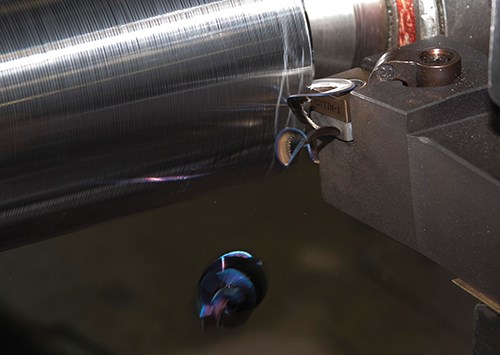Broader Range of Applications Ahead for Ceramic Inserts?
Greenleaf's phase-toughened ceramic inserts could prove that this kind of technology has a future in more universal milling and turning applications.
Share





Ceramic inserts, such as those using whisker-reinforced technology, have traditionally been used for niche applications including high-speed machining of hard metals and heat-resistant super alloys (HRSA). For instance, Greenleaf Corp. offers its WG-300, WG-600 and WG-700 whisker-reinforced grades for shops that are machining those types of challenging materials. That said, the company’s new Xsytin-1 phase-toughened ceramic insert grade is showing promise for a wider range of materials, bridging the gap between conventional carbide and ceramic insert technologies for exotic materials, as well as more conventional metals such as mild and stainless steels.
Bill Greenleaf, national sales and marketing manager, explains that the proprietary phase-toughening ceramic manufacturing process the company developed for this coating-free grade results in predictable, wear- and thermal-shock-resistant inserts that are twice as strong as the company’s WG-300 whisker grade. It also enables the generation of a sharper insert edge, which can lead to reduced tool pressure and better surface finishes. In addition, he says this improved strength means Xsytin-1 can operate at significantly higher feed rates, leading to greater material removal rates and reduced cycle times across a wide range of materials. Similarly, it gives users the option to use this one ceramic grade to machine materials for which they would otherwise use a variety of ceramic grades.
This is helpful because other ceramic grades are commonly used only for select workpiece materials. For example, silicon nitride ceramics are well-suited for cast iron, whisker-reinforced ceramics for high-temp alloys and alumina TiC ceramics for steels. Xsytin-1 is said to machine all of these materials, which means it could be the industry’s first all-purpose ceramic grade. It also shows promise for interrupted cuts, rough turning of forgings and castings, and enabling bigger depths of cut to be taken when turning large-sized workpieces. The company continues to perform in-house test cuts on various different materials, for some of which ceramic insert technology hasn’t typically been thought of as the best option.
Related Content
-
Briquetting Manufacturer Tools Up for Faster Turnaround Times
To cut out laborious manual processes like hand-grinding, this briquette manufacturer revamped its machining and cutting tool arsenal for faster production.
-
How to Troubleshoot Issues With Tool Life
Diagnosing when a tool is failing is important because it sets an expectation and a benchmark for improvements. Finding out why gives us a clue for how to fix it.
-
Selecting a Thread Mill That Matches Your Needs
Threading tools with the flexibility to thread a broad variety of holes provide the agility many shops need to stay competitive. They may be the only solution for many difficult materials.























